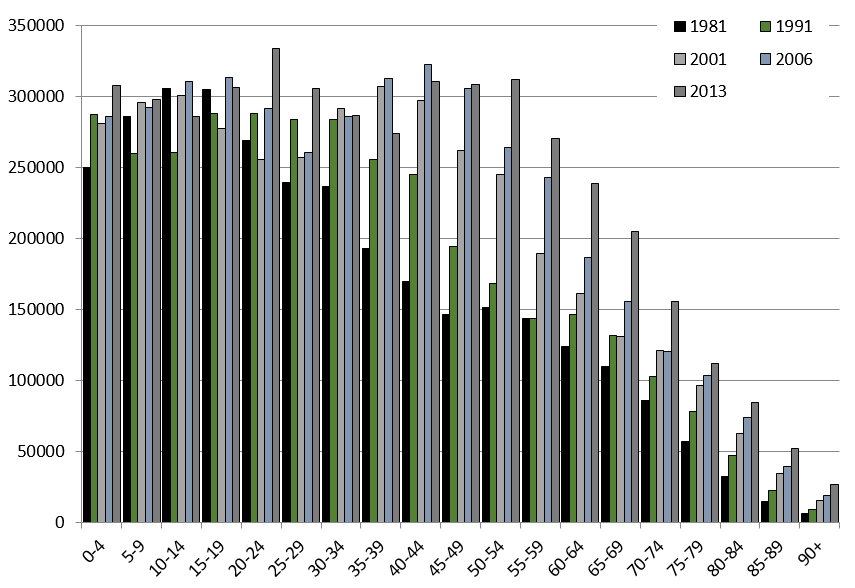New Zealand has arguably been in a trend of ageing for close to a century. All you have to do is look at the steady decline of birth rates and the increase in life expectancy.
You know what it’s like to travel down a long dark tunnel and then to emerge, blinking in the bright sunlight. That’s how the recent SOLGM Community Planning Forum in Christchurch felt as planners from all over New Zealand gathered to celebrate the trials and triumphs of the 2015 Long Term Plan (LTP).
Bruce Robertson, Assistant Auditor-General Local Government summarised the audit office’s review of the LTP consultation documents. While generally complimentary Bruce noted the void of strategies in the plans responding to the changing needs of our ageing population. Reflecting on this finding I have been wondering if we are still trying to get our heads around the magnitude of the ageing trend and the implications and are thus dragging the chain responding to this challenge.
The following table tracks presents three decades of the changing shape of New Zealand’s population.
New Zealand population by age: Tracking change – 1981 to 2013

Looking at national policy, throughout the western work replacement migration is used as a solution to declining and ageing populations. The United Nations investigated how effective a reliance on international migration can be, and found that the challenges rising from both decreasing and ageing populations requires sweeping re-evaluation of current established social, economic and political systems so that a long-term perspective is taken to tackle.
The United Nations note that the rethink needs to start with …
- appropriate ages for retirement;
- levels, types and nature of retirement and health-care benefits for the elderly;
- labour-force participation;
- assessed amounts of contributions from workers and employers needed to support retirement and healthcare benefits for the increasing elderly population; and
- policies and programmes relating to international migration, in particular replacement migration, and the integration of large numbers of recent migrants and their descendants. In this context, it should be noted that immigrants to one country are emigrants from another country. As such, international migration must be seen as part of the larger globalization process taking place throughout the world, influencing the economic, political and cultural character of both sending and receiving countries. While orderly international migration can provide countries of origin with remittances and facilitate the transfer of skills and technology, it also may entail the loss of needed human resources. Similarly, international migration can provide countries of destination with needed human resources and talent, but may also give rise to social tensions. Effective international migration policies must therefore take into account the impact on both the host society and countries of origin. (see http://www.un.org/en/development/desa/population/)
The discussion and responses urged by the United Nations is appropriately pitched at a national level. So where does local government fit in the picture?
Local government can play the migration game too! For in as much as international migration will raise the proportion of young workers (when successful), so too can councils develop strategies to foster internal and international migration. Yet nationally the problem remains the same as with the international conundrum because inward migration in one place is balance by outwards migration in another.
Is the local government response confined to catering for an ageing population? Examples include measures like housing intensification around service nodes, or changing building codes to reflect an ageing populations. However, from my perspective it seems that the local government response has been largely linked to social and health concerns.
How much discussion has there been in New Zealand (and Australia) on how our economic development policies can respond to the ageing challenge? For example, older citizens have lower levels of qualifications and this can be a barrier to employment. Yet, older citizens have a wealth of knowledge and experience so how can councils foster entrepreneurship in our ageing population? For many retirement can be simply a means to explore new opportunities in life.
Ironically the ageing profile of the population presents its own opportunities as consumption patterns change. There will definitely be demand for new goods and services in the aged market. There will also likely be changing costs to infrastructure as technology and commuter patterns adjust to higher proportions of older people.
My discussion outlines the complexity of the ageing challenge and some areas for future debate. A key part to New Zealand’s response must surely come from the lessons learned (or ignored!) internationally in places like the United Kingdom, Japan, Sweden, France, Italy where population decline and ageing trends are advanced. Love to hear your thoughts!











